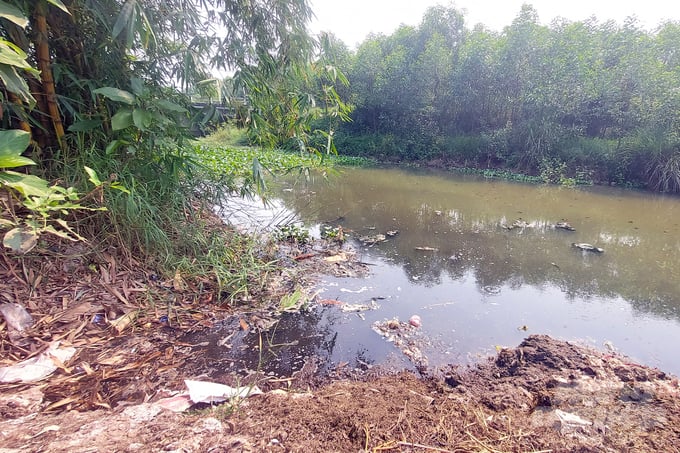
The concentrated slaughterhouses in Quang Tri are really just places where slaughter is concentrated. Picture: From crap.
Mr. Tran Van Ky, head of the quarantine slaughter control department, Quang Tri Livestock and Veterinary Medicine Subdivision, said the province currently has 12 concentrated slaughterhouses. However, this is actually just a place where cattle owners slaughter. This needs to change soon, along with upgrading the infrastructure of the central slaughterhouses.
“In many provinces, the owner of a central slaughterhouse, who also owns the livestock, slaughters and then produces animal products for traders to sell in the markets. However, each slaughterhouse in Quang Tri only slaughters about 20-30 pigs per day on average, but has 5-6 cattle owners. That makes slaughter control more difficult,” said Mr. Ky.
Mr. Thai Van Dinh, owner of a concentrated slaughterhouse in Ward 1, said the facility slaughters about 100-120 pigs every day. However, the owner of the facility is just the infrastructure manager who serves the livestock owners to conduct the night battles and collect fees. Therefore, there are now many stables from many different cattle farmers on the area within this facility.
“There are five barns here owned by five cattle owners. We just manage the facility, boil water, provide water for slaughter. The owner of the facility is not involved in the slaughter, that is the livestock owner’s job,” Dinh said.

In these central slaughterhouses, each cattle owner is assigned a stall and slaughters his own cattle. Picture: From crap.
The slaughterhouse focuses on Dong Luong district and slaughters 7-8 pigs and 8-10 calves every day. This facility not only operates at night, but also slaughters during the day to serve veal stands in Dong Ha city.
Mr. Phan Ba Thanh, a veal worker at the concentrated slaughterhouse in Dong Luong district, said there are 9 livestock owners here. Every pastoralist is a stable, and if necessary, he hires people to slaughter pigs and calves.
Quang Tri’s veterinary industry’s biggest concern is that at present, many concentrated slaughterhouses have been degraded, polluted the environment and fail to ensure veterinary safety and hygiene.
Most of the 12 slaughterhouses concentrated in Quang Tri were built over 20 years ago. The capacity of the slaughterhouses currently does not match the demand. Many facilities today are in residential areas, close to schools, pollute the environment but still need to be operated.
Recently, local authorities have invested in upgrading sewage treatment plants, but under the increasing slaughter pressure, these sewage treatment plants are overburdened. In some concentrated slaughterhouses, the sewage treatment system is almost paralyzed, the water source is discharged directly into the environment, causing serious pollution.
Mr. Thai Van Dinh, owner of a concentrated slaughterhouse in Division 1, said authorities and people in Division 1 are waiting for a large concentrated slaughterhouse built by Dong Ha City People’s Committee in Dong Le Division. There are plans and building guidelines, but so far they have not been implemented.

Many slaughterhouses in Quang Tri pollute the environment and fail to ensure veterinary hygiene and safety. Picture: From crap.
“We’re under a lot of pressure here. People complain a lot about the pollution problem, but if there is no slaughter here, where does the food for the market come from? We hope that the city’s central slaughterhouse will be built soon to move and work there,” Dinh shared.
Mr. Tran Van Ky, Head of Department of Quarantine-Slaughter Control of Quang Tri Animal Husbandry and Veterinary Sub-Department, added that the concentrated slaughterhouses in the province can no longer meet the demand and have many shortcomings. The province of Tri approved the planning project for concentrated Slaughterhouses in Quang Tri province by 2030 with a vision to 2040. Accordingly, the entire province will build new level 21 concentrated slaughterhouses in this period and improve them according to the standards. However, after 5 years of implementation of the project, the entire province has built and modernized 3 concentrated slaughterhouses.
It is necessary to build standardized slaughterhouses soon
“The animal husbandry and veterinary industry proposed to the Quang Tri Provincial People’s Committee to instruct municipalities to remove obstacles soon to quickly build concentrated slaughterhouses to ensure the safety and hygiene of veterinarians. This is also a necessary condition for more effective disease prevention in livestock herds,” said Mr. Tran Van Ky, head of Quarantine-Slaughter Control Department of Quang Tri Animal Husbandry and Veterinary Department.

